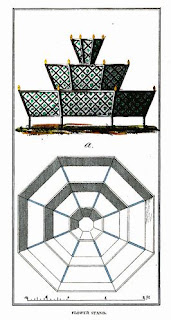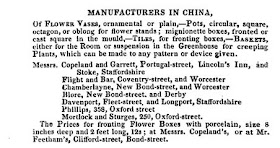Between 1833 and 1847 the Spode company was owned by the partnership of Copeland and Garrett.
As someone interested in both pots and plant history (you may have noticed this from previous
blogs) I was delighted to find records of Copeland and Garrett wares, specifically
associated with planting, in The Floral Calendar; Monthly and Daily for 1839.
Here is a lovely illustration of an octagonal flower stand which is described as 'one of the many combinations with the "running patterns" of the porcelain tiles of Messrs Copeland and Garrett'. For a particular situation, if only one side is to be seen, then 'only half the octagon needs to be faced with tiles' - the comment is added that this is a 'measure which will materially diminish the cost of the stand'. Important if the budget was not to be too extravagant! The stand was made by 'Mr Butler of the Edgware-road' (London).
 |
| Double Pot |
The 'improved or double flower pot' is also featured and these were made in common red clay by Mr J Ashford, red potter, Clapham, Surrey. The gap would be filled with water or moss soaked in water depending what was to be grown. The book says 'porcelain cases or covers are manufactured for these pots by Messrs Copeland and Garrett the elegance of which adds greatly to the effect'. An illustration of the 'common' double pot is shown but I am sorry you will have to imagine the elegant Copeland and Garrett 'porcelain case' which, I suppose, have taken the form of a larger size than the common red pot and highly decorated.
There is also information on enamelled porcelain slabs
'for the Frontages of Flower Boxes or Flower Stands.' Slab is the word for large plaques, much bigger than the usual tile, for which the company was renowned. It was a highly skilled ceramic technique to make them flat and straight - a feat at which the company excelled. Slabs feature in grand houses, for example, as architectural panels set into walls, or for fireplaces set in to steel surrounds and usually highly decorated.
 |
| Design for a Slab for Flower Box or Flower Stand |
The
sketch from the Floral Calendar for
a slab for a Flower Stand is shown here. Apparently 'much amusement and variety may be obtained
from selecting ... from the very elegant and graceful tiles'. The firm would supply
any size, to any design and they could also be used for pavements 'useful and
pleasing' in a greenhouse or conservatory.
I now covet a greenhouse with a floor in 'imitation of a tessellated pavement'!
So once again prepare to be amazed by just what this factory produced and look out for those tiles, slabs, fireplaces and floors in the grand houses worldwide, often overlooked or attributed to other Staffordshire potters - for you can rarely see the backstamp when cemented into place. Of course many of these Copeland and Garrett items are made in collaboration with other specialist retailers, individual craftsmen and manufacturers. This collaboration with other experts in their field began under the Spode ownership and continued until well into the 20th century.
 |
| Copeland & Garrett large 'Flower Boxes' |
 |
| Slab painted with rhododendrons on a basket weave background |
I have included an image of a slab from a set depicting rhododendrons against a basket weave background. The set may have been for a fireplace perhaps or around a door. Made in 1889 this slab dates from after the Copeland and Garrett ownership of Spode but gives you some idea of the sort of thing which was made and continues my floral theme. It is a fully handpainted design but all techniques were used for these types of wares, including printing underglaze and then hand colouring, creating slabs of different designs and cost.
You can find some small plaques, such as for door furniture or actually as insets for fine furniture, on the
V & A website.






